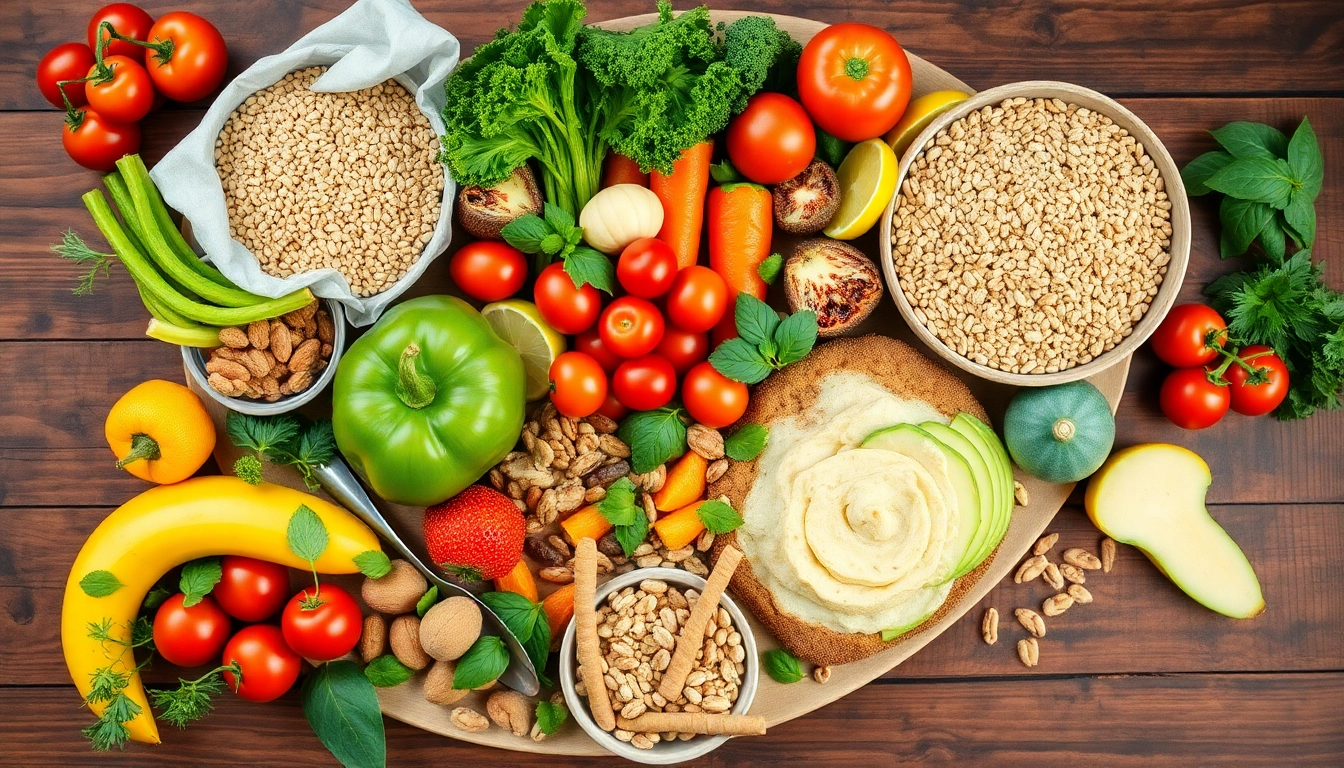The Ultimate Guide to Healthy Food: Top 10 Choices for 2024

Understanding the Importance of Healthy Food
Healthy food is pivotal to the maintenance of good health, influencing everything from our energy levels to how well we can bounce back from illnesses. Choosing healthy food leads to positive health outcomes, supporting both physical and mental well-being. In an era plagued by fast food and overly processed options, understanding the fundamental components of healthy eating is more crucial than ever.
What Constitutes Healthy Food?
Healthy food is generally understood as food that is rich in essential nutrients but lower in caloric content. These foods include a vibrant array of fruits and vegetables, whole grains, lean proteins, and healthy fats. The World Health Organization defines a healthy diet as one that helps maintain or improve health, providing the necessary vitamins and minerals your body needs. It emphasizes a variety of foods, including:
- Fruits and Vegetables: Aim for at least five portions a day, which provide essential vitamins, minerals, and fiber.
- Whole Grains: Foods like brown rice, whole wheat bread, and quinoa offer complex carbohydrates and fiber.
- Lean Proteins: Sources such as chicken breast, fish, beans, and legumes provide the building blocks for body tissues.
- Healthy Fats: Emphasizing sources like avocados, nuts, and olive oil supports heart health and overall wellness.
Benefits of a Balanced Diet
A balanced diet, which incorporates various food groups, significantly enhances overall health. Here are some key benefits:
- Weight Management: Eating nutrient-dense foods helps control weight by promoting satiety while minimizing calorie intake.
- Enhanced Mood: Nutrient-rich foods can boost your mood and cognitive function; for instance, Omega-3 fatty acids found in fatty fish are linked to lower rates of depression.
- Improved Immunity: Regular consumption of fruits and vegetables strengthens the immune system, helping the body fend off illnesses.
- Reduced Risk of Chronic Diseases: A diet filled with whole foods lowers the risk of conditions such as heart disease, diabetes, and certain cancers.
Common Misconceptions about Healthy Eating
Despite the wealth of information available about healthy eating, misconceptions persist that can hinder people’s attempts to improve their diets:
- Healthy Food is Expensive: While some health foods can be costly, many affordable options like beans and seasonal produce are both nutritious and economical.
- Healthy Equals Flavorless: Many people believe that healthy food lacks taste. In reality, fruits, vegetables, and whole grains can be delicious when prepared with creativity.
- Carbs are Bad: Not all carbs are created equal. Whole grains are beneficial, while refined grains can contribute to weight gain and poor health.
Top 10 Healthy Foods You Should Include Daily
Fruits: Nature’s Candy for Health
Incorporating a variety of fruits into your daily diet provides essential vitamins, minerals, and fiber. Here are some standout options:
- Blueberries: High in antioxidants and linked to improved brain health.
- Oranges: Rich in Vitamin C, oranges can boost immune function.
- Bananas: A great source of potassium and fiber, perfect for muscle and heart health.
Vegetables: The Key to Nutrient-Dense Meals
Vegetables are packed with nutrients and low in calories, making them essential for a healthy diet. Key vegetables include:
- Spinach: An excellent source of iron and vitamins A and C.
- Broccoli: Contains sulforaphane, which has been found to have cancer-fighting properties.
- Carrots: Known for their beta-carotene content, which promotes eye health.
Nuts and Seeds: Packed with Nutrition
Nuts and seeds are nutrient-dense, offering healthy fats, protein, and fiber. Consider including:
- Almonds: High in vitamin E and antioxidants.
- Chia Seeds: Rich in omega-3 fatty acids, fiber, and protein.
- Walnuts: Known for promoting heart health due to their high content of omega-3 fatty acids.
How to Incorporate Healthy Food into Your Diet
Meal Prep Ideas for Healthy Eating
Meal prepping can make healthy eating convenient and efficient. Strategies include:
- Batch Cooking: Prepare large quantities of staple foods, such as quinoa or brown rice, to use throughout the week.
- Portion Control: Divide meals into individual servings to make healthy choices easy when hunger strikes.
- Recipe Planning: Choose recipes that incorporate various food groups for balanced meals, such as stir-fries or grain bowls.
Quick Healthy Snack Options
Healthy snacking can prevent overeating at mealtimes. Some ideal options include:
- Greek Yogurt with Fruits: A great source of protein and probiotics.
- Sliced Apples with Almond Butter: Combines fiber, vitamins, and healthy fats.
- Veggie Sticks and Hummus: Provides fiber and protein in a satisfying crunch.
Making Healthy Eating Convenient
Convenience is key to maintaining healthy eating habits. Consider these tips:
- Keep Healthy Foods Visible: Store fruits and vegetables at eye level in the fridge to make them more accessible.
- Keep Essentials On Hand: Stock healthy pantry items like canned beans, frozen vegetables, and whole grains.
- Utilize Kitchen Gadgets: Slow cookers and instant pots can help prepare wholesome meals with minimal effort.
Common Challenges in Maintaining Healthy Eating Habits
Overcoming Temptations for Unhealthy Food
Many face temptations for unhealthy foods. Strategies for overcoming this challenge include:
- Keep Unhealthy Foods Out of the House: If they’re not around, you’re less likely to indulge.
- Mindful Eating: Practice being present during meals, which can help you feel satisfied with healthier options.
- Substitutions: Replace unhealthy snacks with healthier equivalents, such as popcorn instead of chips.
Dealing with Time Constraints
Busy schedules can make healthy eating seem challenging. However, with planning and preparation, it becomes manageable:
- Set Aside Time Each Week: Designate specific times for meal prep to avoid last-minute unhealthy choices.
- Utilize Convenience Foods Wisely: Frozen vegetables and pre-washed salad greens can save time while still being nutritious.
- Quick Recipes: Familiarize yourself with a repertoire of healthy meals that can be prepared in 30 minutes or less.
Understanding Emotional Eating
Emotional eating can derail healthy eating efforts. Addressing this requires:
- Identify Triggers: Recognize emotional triggers that lead to unhealthy eating patterns.
- Healthy Coping Mechanisms: Replace eating with other activities, such as exercise or meditation, to manage emotions.
- Keep a Food Journal: Logging meals can help you gain insight into your eating habits and emotional connections to food.
Tracking Your Progress with Healthy Food Habits
Setting Realistic Goals for Healthy Eating
Goals are vital for maintaining motivation. To set achievable goals, consider the following:
- Be Specific: Instead of saying, “I want to eat healthier,” specify, “I will eat three servings of fruits and vegetables daily.”
- Monitor Progress: Regularly evaluate your goals to see what works and what may need adjustment.
- Celebrate Milestones: Acknowledge even small victories on your journey towards healthier eating.
Using Apps to Monitor Your Diet
Technology can assist in maintaining healthy habits. Many applications allow users to:
- Track Nutritional Intake: Log what you eat to gain insights into your eating patterns.
- Set Reminders: Apps can remind you to drink water or take breaks for meals.
- Connect with Others: Some platforms allow you to share your progress and stay motivated with a community.
Adjusting Your Diet Based on Feedback
Listening to your body is key. Adjusting your diets, such as through the following, can promote better results:
- Pay Attention to Energy Levels: Notice if certain foods make you feel energized or sluggish.
- Track Mood Changes: Observe how different foods affect your mood and mental clarity.
- Stay Flexible: Be willing to modify your diet based on what works and what doesn’t.






